Lebensräume
Special species need special habitats
Our target species depend on a particular environment. This includes not only natural habitats, but also different habitat types that have been created by centuries-long human use. Habitats such as Nardus, Molinia grasslands, lowland and mountain hay meadows still require to be used by humans today. However, this use must be extensive, to preserve their special species composition. In the forests, structurally-rich and old deciduous forests represent important breeding, nesting or foraging habitats.
Habitat type 6230: Nardsus grasslands
| Indicator species: | Species that can cope with few nutrients, like the eponymous Nardus stricta, Arnica montana, Briza media, Galium saxatile and Pedicularis sylvatica. |
|---|---|
| Management: | Nardus grasslands have been usually created by extensive grazing, which has removed nutrients from the soil over decades. Therefore, grazing is also the target management option. Alternatively, extensive mowing (without any fertilization) can also maintain the species composition typical to these habitats. |
| Threat: | This very lean habitat type with its typical species composition is endangered by incipient nutrient input, such as liquid manure, solid manure or liming. Intensification of land use, whether through overgrazing or nutrient inputs, can quickly alter its rare species composition. |
| Characteristics: | Several native orchid species, such as Dactylorhiza maculata, Dactylorhiza majalis, and Platanthera chlorantha can be found in well-mamaged Nardus grasslands. |
| Presence in the project area: | Nardus grasslands account for about 33 ha (0.7%) of the project area. A major stronghold of this habitat type is the Special Area of Conservation "Buchheller-Quellgebiet” (near Burbach-Lippe). |
| Target species | The Marsh Fritillary (Euphydryas aurinia) uses, among others, Arnica as one of the most important nectar plants. The devil's-bit, the only food plant of the caterpillars in our region, is also a typical species of moist Nardus grasslands. The Whinchat can also be often found if singing and perching areas area available |
| Measures: |
|
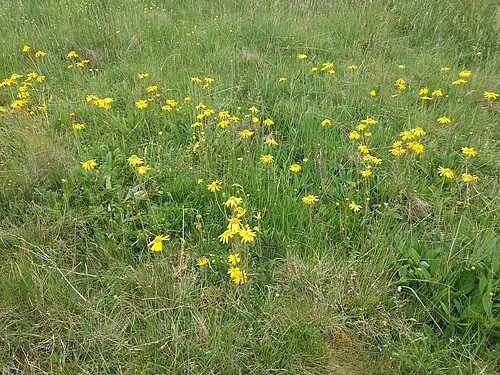
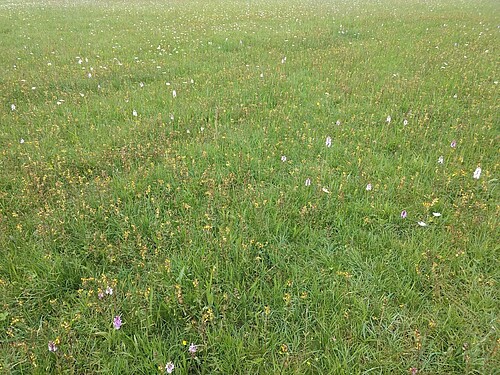
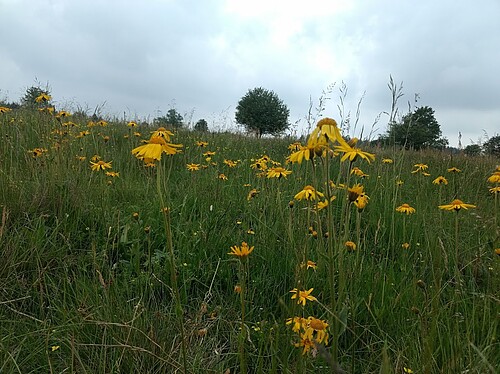
Habitat type 6430: Hydrophilious tall herb fringe communities
| Indicator species: | Typical species of these wet tall herbaceous meadows are Filipendula ulmaria, Trollius europaeus, Lythrum salicaria, Achillea ptarmica, Bistorta officinalis, Eupatorium cannabinum and Aconitum napellus. |
|---|---|
| Management: | Occasional mowing (e.g., biennial or perennial) prevents increasing succession and maintains the habitat-typical species composition. |
| Threat: | Both, intensification through frequent mowing or grazing or the abandonment can threaten this habitat type. In the long term, the abandonment of use leads to scrub encroachment, which displaces the valuable species composition. A change in the water balance can also has a negative effect on the tall herbaceous vegetation. |
| Characteristics: | Due to the diverse species composition and the abundance of flowers in the tall herbaceous meadows, numerous insect species can be observed here, especially in the summer months. |
| Presence in the project area: | Hydophilious tall herb fringe communities occur on a total area of 4 ha and are closely interlinked with the lowland and mountain hay meadows. |
| Target species | The Whinchat, in particular, uses the tall-growing perennial shrubs as perching sites and the compacted vegetation as a nesting site; there is also a rich food supply here in terms of insect abundance. When Bistort (Bistorta officinalis) is sufficiently abundant, the Violet Copper uses these habitats to lay eggs and for foraging. |
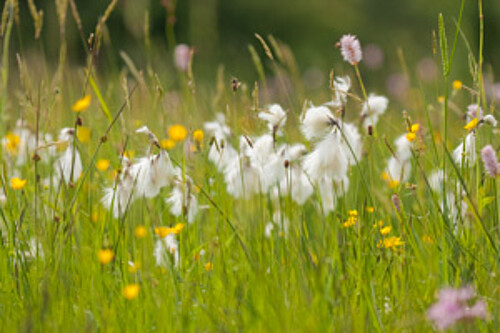
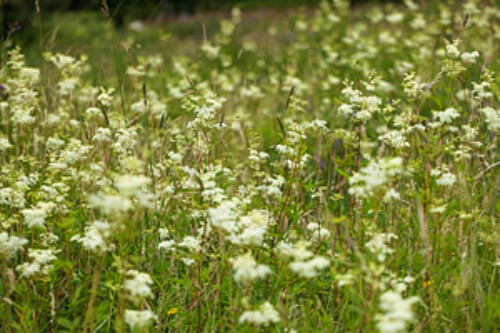
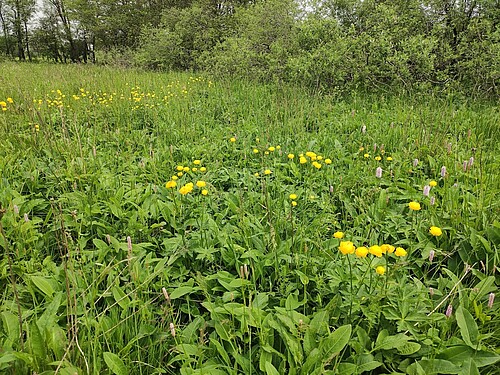
Habitat type 6510: Lowland hay meadows
| Indicator species: | Lowland hay meadows can be differentiated into moist and dry meadows, which differ in their typical species inventory. Typical identification species include the Arrhenatherum elatius, Leucanthemum vulgare, Knautia arvensis and Centaurea jacea. In wetter areas, Sanguisorba officinalis can be found. |
|---|---|
| Management: | Extensive mowing or grazing. Ideally, the first mowing should be done from mid-June onwards, so that the grasses can come to main bloom. If meadow nesting birds are present, not until mid-July. A second mowing can be carried out from the end of August onwards. Alternatively, a second grazing can be carried out. Depending on the appearance of the species community, a light fertilization (maintenance fertilization) with solid manure can be beneficial. |
| Threat: | Intensification of grassland use, through more frequent mowing, increased nutrient input or too high livestock densities. In contrast to that, abandonment and the resulting scrub encroachment also poses threats to this habitat type. |
| Characteristics: | Lowland hay meadows, either moist or dry, are characterized by high species numbers, which causes the meadows to bloom colorfully in summer. The great plant diversity in turn attracts numerous and sometimes rare insect species. |
| Presence in the project area: | Lowland hay meadows currently cover a total of 66.4 ha in the project area and are often closely intertwined with the habitat types "hydrophilious tall herb fringe communities" and "mountain hay meadows". |
| Target species: | For the Whinchat, lowland hay meadows are among the most important habitat types. The Red Kite especially uses the freshly mown meadows for foraging. |
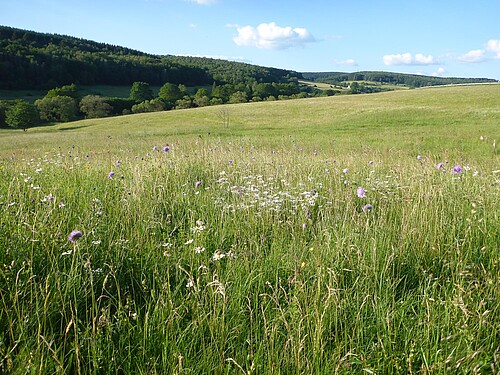
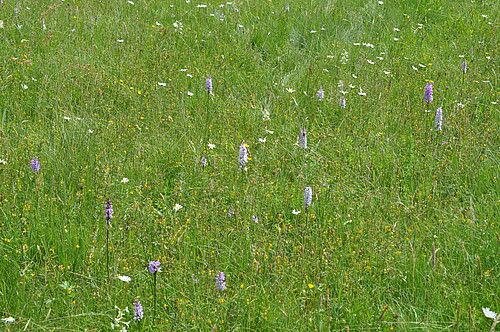
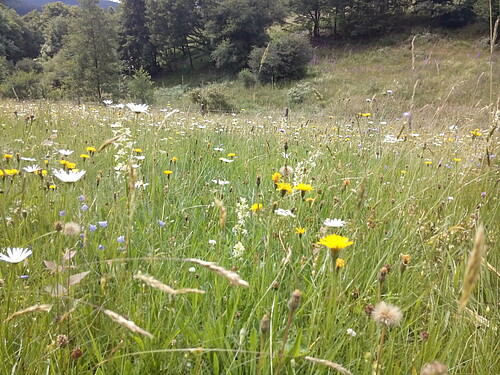
Habitat type 6520: MOUNTAIN HAY MEADOWS
| Indicator species: | Typical plant species of mountain hay meadows include Potentilla errecta, Alchemilla monticola, Rhinanthus minor, Bistorta officinalis, Trollius europaeus and Trisetum flavescens. |
|---|---|
| Management: | Extensive mowing or grazing. Ideally, the first mowing should be done from mid-June onwards, so that the grasses can come to main bloom. If meadow nesting birds are present, not until mid-July. A second mowing can be carried out from the end of August onwards. Alternatively, a second grazing can be carried out. Depending on the appearance of the species community, a light fertilization (maintenance fertilization) with solid manure can be beneficial. |
| Threat: | Intensification of grassland use, through more frequent mowing, increased nutrient input or too high livestock densities. Abandonment and associated scrub encroachment can also threaten these habitat types. |
| Characteristics: | As the name suggests, mountain hay meadows develop only at higher altitudes, about 400 m above sea level. In lower regions they are replaced by the species-rich lowland hay meadows, either in their moist or dry form. |
| Presence in the project area: | Mountain hay meadows can be found on about 58.5 ha of the project area and are often intertwined with species-rich lowland hay meadows or hydrophilious tall herb fringe communities. |
| Target species: | For the whinchat, the mountain meadows are among the most important habitat types. But the red kite also makes particular use of the freshly mown meadows for hunting. |
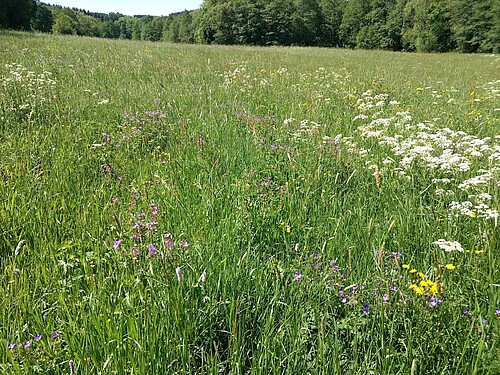
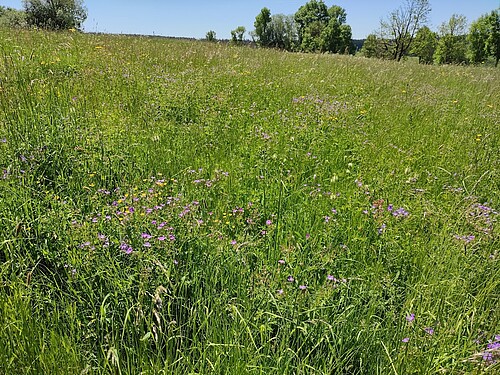
Habitat type 91E0*: ALLUVIAL FORESTS
| Indicator species: | Alluvial forests are dominated by tree species that can cope with moist soils, including black alder (Alnus glutinuosa), common ash (Fraxinus excelsior), downy birch (Betula pubescens), and brittle willow (Salix fragilis). |
|---|---|
| Management: | Alluvial forests should remain without any management or use, so that sufficient old and dead wood can be produced. However, it can be beneficial to remove non-habitat-typical tree species and to ensure natural flood dynamics on a permanent basis. |
| Threat: | The major threats to this habitat type are caused by river engineering, in particular bank construction, barrage construction as well as straightening of the watercourse. This results in a change in the flood dynamics, which then impacts the species composition of the alluvial forests. Afforestation with non-habitat-typical tree species also permanently alters this special habitat type. |
| Characteristics: | Alluvial forests provide important flood protection along watercourses. The natural floodplain allows the river to spread out during sustained precipitation, while the flow velocity is significantly reduced due to the vegetation. |
| Presence in the project area: | This habitat type occurs on about 53 ha of headwater areas of rivers and along streams. The largest portion comprises the Special Areas of Conservation “Weier- und Winterbachtal" and "Rübgarten". |
| Target species: | The softwood found in the alluvial forests is mainly used by the different woodpecker species, the Middle-spotted Woodpecker (Dendrocoptes medius), Grey-headed Woodpecker (Picus canus) and the Black Woodpecker (Dryocopus martius). But also the Violet Copper (Lycaena helle) benefits from these highly complex habitats if connected to preferred grasslands. |
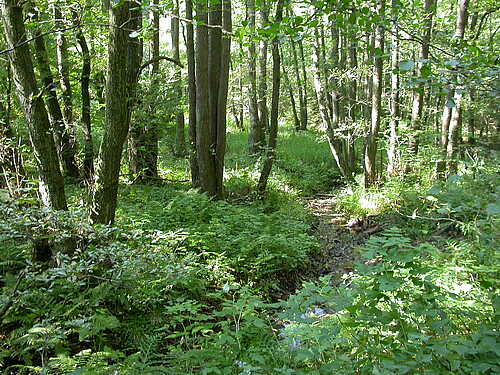
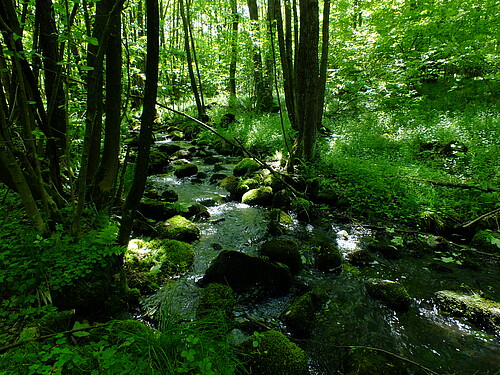
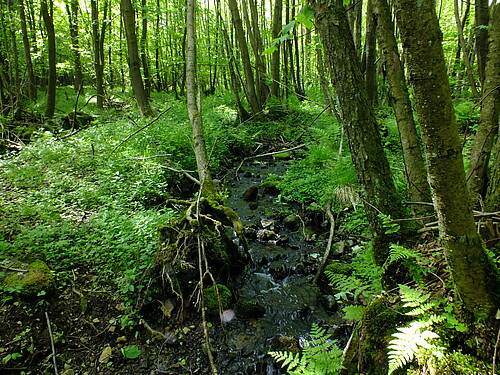
Habitat type 9110: Luzulu-Fagetum beech forests
| Indicator species: | Due to poor light conditions on the ground, beech forests have only a weakly developed herb layer. Eponymous Luzula luzuloides together with wiregrass (Deschampsia spp.) and blueberry (Vaccinium spp.) are typical species of the herb layer. Among the dominant red beech (Fagus sylvaticus), oaks can be occasionally found (Quercus robur or Quercus petraea) mixed with sycamore maple (Acer pseudoplatanus). |
|---|---|
| Management: | Natural development must be ensured with sufficient old and dead wood production to provide habitat for various bird and bat species. |
| Threat: | Silvicultural measures, especially afforestation with coniferous trees, excessive game populations, and increasing drought and heat related to climate change. |
| Characteristics: | Without human use, soil acidic beech forests are considered to be the major forest type in middle Europe. As a result, Germany bears a special responsibility worldwide for the preservation of beech forests. |
| Presence in the project area: | Luzulu-Fagetum beech forests currently cover about 124 ha in the project area. This, however, only contributes to 3.7% of the total forest area. |
| Target species: | Luzulu-Fagetum beech forests are characterized by a high proportion of old and dead wood, which is used especially by our woodpecker target species, the Black Woodpecker (Dryocopus martius) and the Gray-headed Woodpecker (Picus canus). The Red Kite (Milvus milvus) further uses these forests for breeding. |
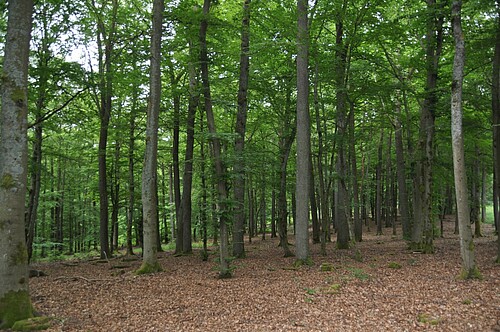
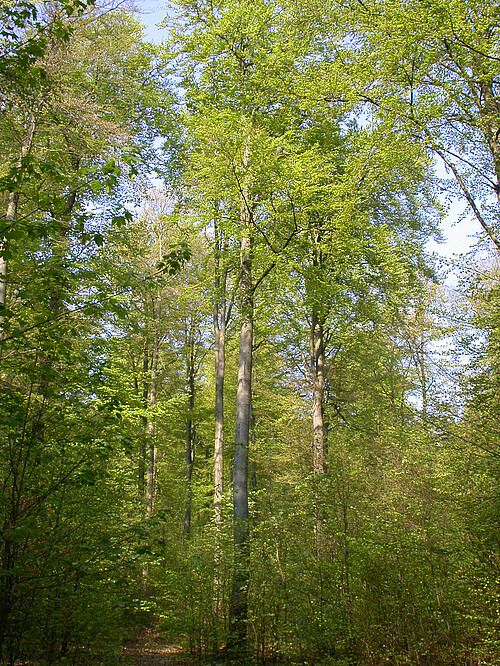
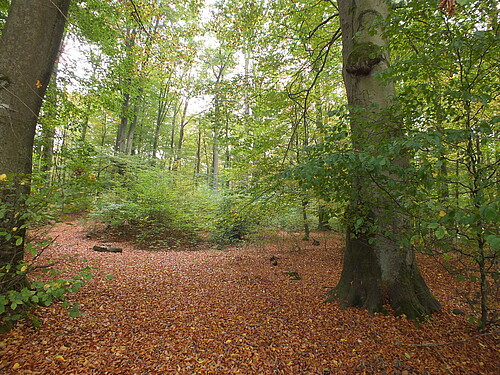
9180 Canyon and hillside mixed forests
Characteristic species: | In canyons or on steep slopes with increased humidity and coarse substrates of stone blocks (block debris) or coarse gravel, sycamore maple (Acer pseudoplatanus) and ash (Fraxinus excelsior) dominate the tree layer. Elder (Sambucus racemosa, Sambucus nigra) may occur in the shrub layer. The herb layer is usually species-poor, but acid-tolerant species such as Robert geranium (Geranium robertianum), wavy hair grass (Deschampsia flexuosa) or wood sorrel (Oxalis acetosella) are typical. Other species that may be found include wood fescue (Festuca altissima) and grove bluegrass (Poa nemoralis). Ferns such as the polypody (Polypodium vulgare) and the broad-leaved buckler fern (Dryopteris dilatata) are also found in this biotope type. |
|---|---|
| Management: | This habitat can be supported by reducing the proportion of non-native trees, promoting native trees, developing a permanent forest and promoting deadwood, both lying and standing. |
Threats: | Like all forest habitats, this habitat is threatened by intensive forestry or one-sided changes to the tree population. Furthermore, high game populations can also damage the undergrowth. |
| Characteristics: | In hillside and ravine forests, you can find typical forest birds such as black, lesser and green woodpeckers, stock doves, pied flycatchers, black storks, marsh tits and woodcocks. Amphibians and insects also benefit from this rocky, humid habitat. |
| Presence in the project area: | This habitat type occurs in our project area in an area of around 23.4 ha and is distributed across the FFH areas ‘Rübgarten’ (5.8 ha), ‘Weier- und Winterbach’ (11.4 ha) and ‘Großer Stein mit umgebenden Buchwäldern’ H3,5 ha). In the project area, this habitat is found in small, cool, damp locations with a distinct herb layer. |
| Target species: | The middle spotted woodpecker (Dendrocoptes medius) particularly benefits from this habitat type, where the old-growth stocks provide a food source rich in insects and the forest structure also offers nesting opportunities. |
| Measures: |
|









